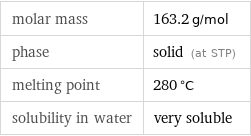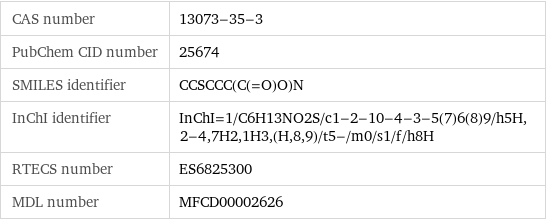Input interpretation

L-ethionine
Chemical names and formulas

formula | C_2H_5SCH_2CH_2CH(NH_2)CO_2H Hill formula | C_6H_13NO_2S name | L-ethionine IUPAC name | (2S)-2-amino-4-(ethylthio)butanoic acid alternate names | (2S)-2-amino-4-ethylsulfanyl-butanoic acid | ethionine | L-2-amino-4-(ethylthio)butyric acid | S-ethylhomocysteine mass fractions | C (carbon) 44.1% | H (hydrogen) 8.03% | N (nitrogen) 8.58% | O (oxygen) 19.6% | S (sulfur) 19.6%
Lewis structure

Draw the Lewis structure of L-ethionine. Start by drawing the overall structure of the molecule, ignoring potential double and triple bonds: Count the total valence electrons of the carbon (n_C, val = 4), hydrogen (n_H, val = 1), nitrogen (n_N, val = 5), oxygen (n_O, val = 6), and sulfur (n_S, val = 6) atoms: 6 n_C, val + 13 n_H, val + n_N, val + 2 n_O, val + n_S, val = 60 Calculate the number of electrons needed to completely fill the valence shells for carbon (n_C, full = 8), hydrogen (n_H, full = 2), nitrogen (n_N, full = 8), oxygen (n_O, full = 8), and sulfur (n_S, full = 8): 6 n_C, full + 13 n_H, full + n_N, full + 2 n_O, full + n_S, full = 106 Subtracting these two numbers shows that 106 - 60 = 46 bonding electrons are needed. Each bond has two electrons, so in addition to the 22 bonds already present in the diagram add 1 bond. To minimize formal charge oxygen wants 2 bonds and carbon wants 4 bonds. Identify the atoms that want additional bonds and the number of electrons remaining on each atom: Fill in the 1 bond by pairing electrons between adjacent highlighted atoms: Answer: | |
3D structure

3D structure
Basic properties

molar mass | 163.2 g/mol phase | solid (at STP) melting point | 280 °C solubility in water | very soluble
Units

Chemical identifiers

CAS number | 13073-35-3 PubChem CID number | 25674 SMILES identifier | CCSCCC(C(=O)O)N InChI identifier | InChI=1/C6H13NO2S/c1-2-10-4-3-5(7)6(8)9/h5H, 2-4, 7H2, 1H3, (H, 8, 9)/t5-/m0/s1/f/h8H RTECS number | ES6825300 MDL number | MFCD00002626
Toxicity properties

RTECS classes | tumorigen | mutagen